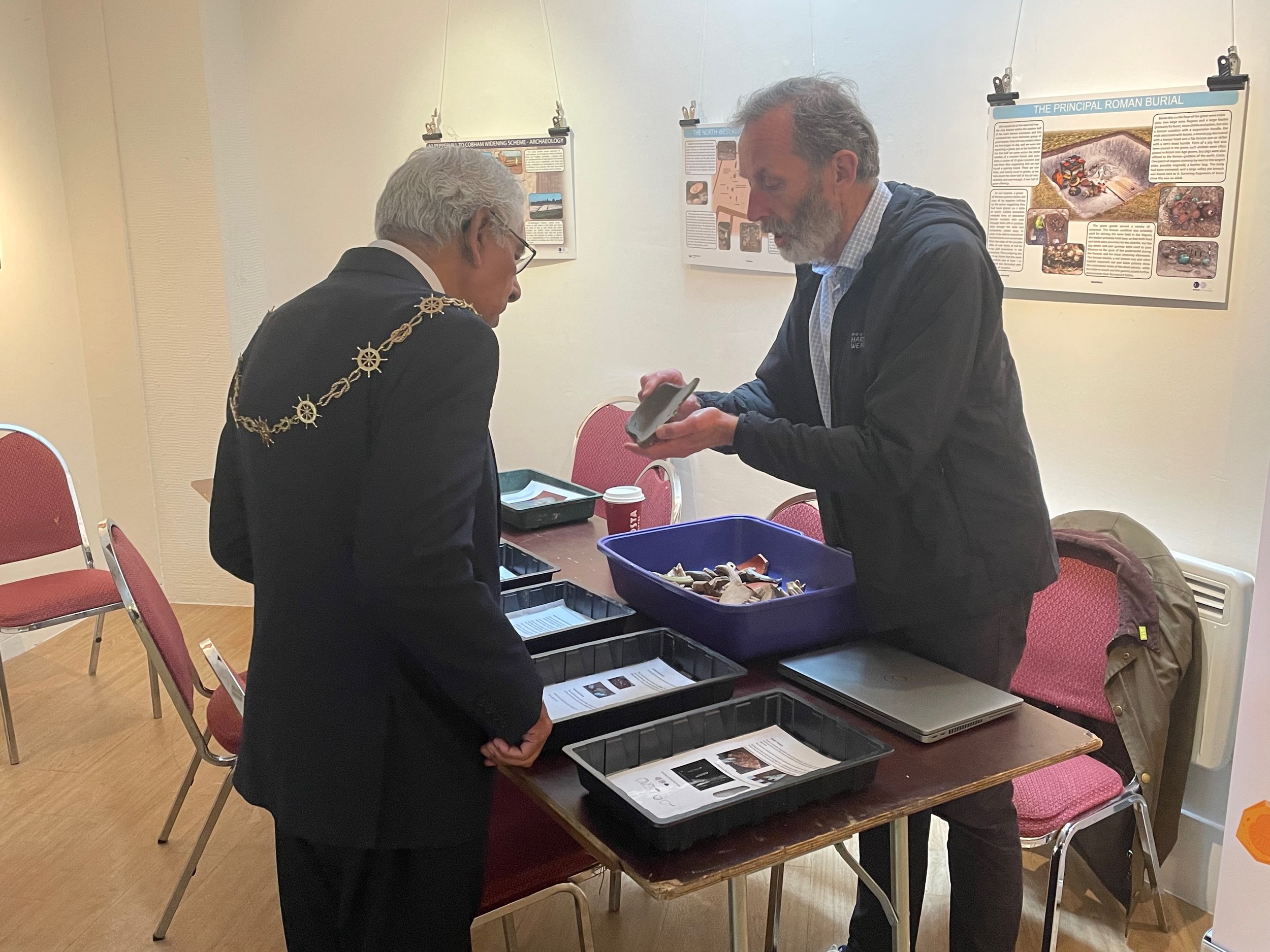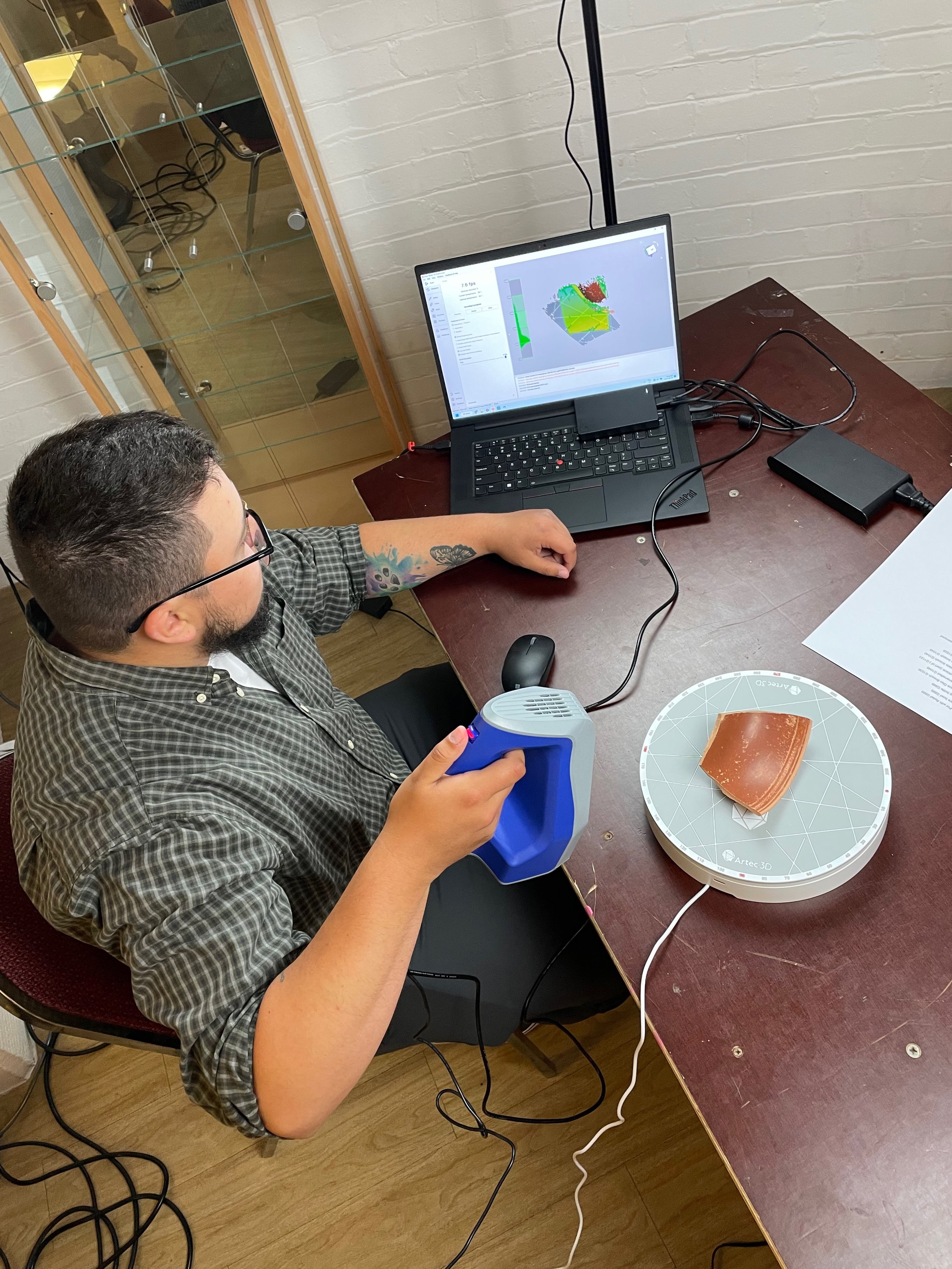DRAGEN Tales

Rock Art from Recent Excavations at Street House (2010 - 2024)
Read Dr. Steve Sherlock’s report on the rock art found at Street House.
Excavations since 2010 at Street House, near Loftus, have found over twenty examples of prehistoric rock art (figs. 1&2). Rock Art is argued to date from the Later Neolithic period to the Early Bronze Age (c.2,300 – 1,500BC). This “art” is created by carving or pecking with a hard stone upon a softer sandstone. These can be earth fast rocks or “portable” boulders within monuments such as cairns and burial mounds.

Four Thousand Years of Pre-History: Excavating the Neolithic, Bronze, and Iron Ages at Street House, UK with Dr. Stephen Sherlock
On Wednesday, October 9th the DRAGEN Lab hosted the first free lecture of the 2024/2025 academic year with an exciting summary of Dr. Stephen Sherlock’s archeological work in the United Kingdom.

Digging for Streethouse: Breaking Ground with Archaeologist Dr. Stephen Sherlock
On Saturday August 10th, our team of students in North Yorkshire broke ground at an archaeological dig in Streethouse, UK. Just north of Loftus in an old farm field, the site was first discovered as a focus of curiosity when Dr. Stephen Sherlock had hired a third party to conduct a geophysical scan of the terrain. Upon analysis of the results, Sherlock noticed that there were some indicators of archaeological activity in the field.

GPS and Lidar Drone Training: Transdisciplinary Collaboration at Streethouse Farm
Last week, our Streethouse team received GPS training, and learned about the process of Lidar drone scanning on-site by a third party called Tri-Tech Surveys, out of North Yorkshire. Throughout the process, our representative named Johnny, supported our team in learning the basics to capturing GPS location data, and had students mastering the skill of using a surveying GPS in preparation for sedimentary core sampling which would begin the next day. This is a skillset that would also later be applied to archaeological field work with Dr. Stephen Sherlock.

Medieval Iron Smelting Demonstration in Sutton Bank National Park
While on their research assignments in north Yorkshire, members of our team were eager to attend a medieval iron smelting demonstration in Sutton Bank. This area of the UK was an historic site for medieval iron bloomeries and smelting.

Introduction to Streethouse Trip 2024
During the first week of August 2024, a small group of students from the DRAGEN Lab began a month-long research and work assignment that has taken them to Streethouse, located in North Yorkshire. For the duration of this assignment, the team will be participating in various research and experiential learning opportunities to support work being conducted by Dr. Stephen Sherlock, a project collaborator, and his archaeological expeditions at the Streethouse Farm.

Eating Sandstone, Eating a Story: Part 2
It is an odd thing to do, isn’t it? To dig out dust from a brick of a church and eat it? Even more curious is the practice surrounding this belief when considering that the bricks of the outer church were not themselves miraculous, but simply close to the miraculous wooden statue of Saint Job.

Eating Sandstone, Eating a Story
The wooden statue of Saint Job at Sint-Martinuskerk (Church of Saint Martin) sits within a glass case elevated about five feet off the ground. Job is magnificent — he is handsome and captivating despite being small in size. Miraculously, despite fires, thefts, and the arduous passage of time, this statue of Saint Job remains housed in the village church of Wezemaal, Belgium, which saw its veneration by pilgrims in the late Middle Ages

3D Scanning Neolithic, Iron Age, Roman and Anglo-Saxon Artifacts from Streethouse and Norton
Week three of the work term for members of the DRAGEN Lab team led them to North Yorkshire, to engage with artifacts discovered during archaeological excavations at Streethouse from 1979 to the present day.

Enclosed Gardens and Pilgrim Badges
When I visited Sint-Dimpnakerk (The Church of Saint Dymphna) in Geel, Belgium at the end of May to learn more about the church and the history surrounding Saint Dymphna, I did not anticipate finding six pilgrim badges in a sixteenth-century enclosed garden (Besloten Hofje) in a corner of the church.

Saint Dymphna, Lost Heads, and Material Revelation
Two years ago, I became interested in several Saint Job pilgrim badges from a village church in Wezemaal, Belgium. This church saw throngs of medieval pilgrims flock to its site for healing and protection from physical ailments. I now find myself drawn to another pilgrimage site just thirty-five kilometres north of Wezemaal in Geel, Belgium, where pilgrims flocked not for healing of their bodies, but of their minds. Sint-Dimpnakerk (the Church of Saint Dymphna) marks where the legendary seventh-century Dymphna is honoured as both patron saint of the city and of mental illness.

Wrapping Up: 3D Scanning & Hands-On Archaeology Exhibit at Gravesend, UK
From June 5-16th members from the DRAGEN lab team travelled to Gravesend, UK to participate in 3D scanning and public history Hands on Archaeology: Unearthing Gravesham’s Past exhibition at the Woodville Civic Centre. Throughout the two-week work term at this exhibition, team members were trained to 3D scan local Roman and Anglo-Saxon archaeological finds…

Explorations in Shorne Woods: Archaeology in Action
During their time in Gravesend, UK, members of our team visited Shorne Woods County Park in Kent to see Randall Manor with Andrew Mayfield, Community Archaeologist with Heritage Conservation Group, Kent County Council. The Randall Manor is a medieval manor house that was the focal point of a 10-year archaeology excavation funded by a Heritage Lottery Fund from 2006 to 2015.

The Use of Communications Tools to Engage Communities in Public History: Unearthing Gravesham’s Past
Effectively engaging general public audiences in history and the importance of historical artifacts can be quite troublesome in most cases. In particular, promoting events that involve elements of history and scientific research is considerably difficult to gain public interest.

3D Scanning at the Woodville Civic Centre in Gravesend, UK
During the first week of June 2023, a small group of students from the DRAGEN Lab began a two-week research assignment at the Woodville Civic Centre in Gravesend, England, in partnership with the Hands on Archaeology: Unearthing Gravesham’s Past project.

Musings on Decay: Announcing Deimer’s Exhibit
Over the past several months, Kendall Diemer has developed familiarity with the historical and material aspects of the medieval past in order to curate two exhibitions based on the collection of medieval objects housed at the University of Waterloo’s DRAGEN Lab. We are happy to announce the start of Kendall’s second exhibition, which explores the collection through the lens of decay. The exhibition will take place from Monday, March 13th to Monday, April 3rd at St. Jerome’s University (SJ1, second floor). This blog post serves as an introduction to the inspiration behind the exhibition and to Kendall’s views on the topic.

Margery Kempe and Pilgrim Badges
Today marks the commemoration day of a remarkable English mystic, Margery Kempe, a middle-class, medieval woman born in what is now King’s Lynn, Norfolk around 1373, where she died after 1439. We know of Kempe’s life through the chance discovery of her dictated work, The Book of Margery Kempe, in the twentieth century. From her Book, which is considered the first autobiography written in English, we learn that Kempe was married and bore fourteen children before negotiating a chaste marriage.

Conservation (and a 3D Scanner!) Comes to the Castle
In early May 2022, the science lab of the Bader International Study Centre (BISC) became the nexus where hundreds of artefacts with drastically different histories, material properties, and provenance all came together. Iridescent glass fragments, WWII Royal Air Force porcelain, and archaeological iron horseshoes, all found on the grounds of Herstmonceux, currently occupy the same space as a large collection of Roman artefacts on loan from local Bexhill Museum. The former, temporarily removed from the Castle’s Visitor Centre, have been assessed, documented, and digitised by graduate students in Art Conservation and in Digital Media, and the latter, catalogued by undergraduates participating in the BISC Archaeology Field School.

Agnus Dei Badges
The Agnus Dei (Lamb of God) is an important, ancient symbol in Christian iconography. The symbol is a representation of Christ’s sacrifice, as demonstrated by the lamb, and his victory, as demonstrated by the cross. The term is associated with the Paschal lamb sacrificed during Passover (as seen in Exodus chapter 12), which then later came to be a symbol associated with Easter due to the occurrence of Passover and Easter in the same time period.

Emerging Digital Interpretive Opportunities for Visitors at Herstmonceux Castle
While the COVID-19 pandemic has resulted in drastic social and economic impacts, the need for an escape through tourism remains steady. Heritage Tourism remains one of the industry’s most popular forms. Heritage Tourism can be as ‘travellers seeing or experiencing built heritage, living culture or contemporary arts’. Encountering a site and its stories can transport you back to a different time and place, which is something many people could use given the current state of the world. A great example of a heritage site with striking tangible features, and various compelling, hidden stories is the Herstmonceux Castle Estate.
